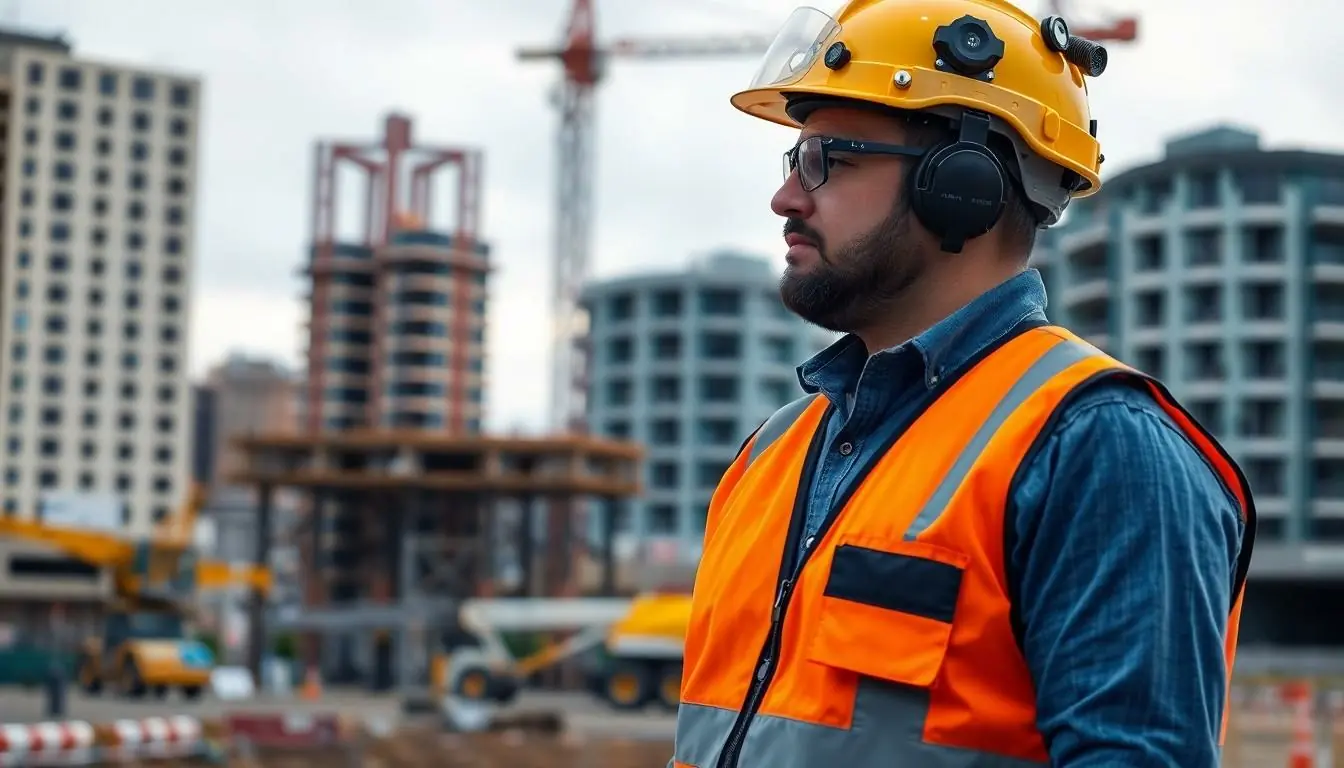Table of Contents
ToggleIn a world where accidents can happen faster than you can say “safety first,” safety wearables are becoming the unsung heroes of everyday life. These nifty gadgets are like having a personal bodyguard, but without the intimidating sunglasses and earpiece. Whether it’s a smart helmet that senses danger or a wristband that sends alerts when things go south, these devices are here to keep you safe while you go about your daily adventures.
Imagine strutting around with tech that not only looks cool but also has your back—literally. Safety wearables combine innovation with style, proving that being cautious doesn’t mean sacrificing flair. As they continue to evolve, these wearables are turning the mundane into the extraordinary, making safety not just a priority but a fashionable statement. Dive into the world of safety wearables and discover how they’re revolutionizing the way we protect ourselves and each other.
Overview of Safety Wearables
Safety wearables play a critical role in enhancing personal safety. These devices function with advanced technology, enabling users to stay connected and protected in various environments. Examples include smart helmets that incorporate communication systems and alert wristbands designed for emergency notifications.
A range of industries benefits from safety wearables. Construction workers use smart helmets to receive real-time updates, while outdoor enthusiasts rely on alert wristbands for tracking and notifying emergencies. The integration of sensors into wearables allows for features like fall detection and location tracking, improving response times during accidents.
Fashion and functionality intersect in safety wearables. Users appreciate designs that harmonize style with practicality, making these devices appealing for daily wear. Wearables like chic jackets equipped with safety technology also contribute to increasing awareness about personal safety, blending aesthetic appeal with protective features.
Investment in safety wearables continues to grow. The global market for these devices surged to approximately $1.5 billion in 2022 and is expected to reach over $4 billion by 2026, reflecting an increasing demand for enhanced personal protection.
An ever-expanding array of safety wearables fuels innovation in this sector. Developers focus on integrating more features, such as health monitoring and environmental sensors, into existing designs. As technology evolves, these advancements improve versatility and usability further, making personal safety more accessible across demographics.
Innovation remains at the forefront of safety wearables, as companies prioritize collaboration with users to better understand needs. This user-centered approach shapes future designs, ensuring safety wearables provide practical solutions while remaining stylish.
Types of Safety Wearables

Safety wearables come in various forms, each designed to enhance protection in specific environments. The main categories include smart helmets, smart vests, and wearable sensors, which exemplify how technology integrates with personal safety.
Smart Helmets
Smart helmets significantly improve safety for construction workers and outdoor enthusiasts. Equipped with advanced features, these helmets provide real-time updates regarding environmental hazards. Integrated sensors detect impacts, alerting wearers to potential dangers immediately. They often include communication systems, allowing teams to coordinate and respond effectively in emergencies. Comfort remains a priority, as many designs feature ventilation systems and adjustable fittings, ensuring users remain comfortable during extended wear.
Smart Vests
Smart vests serve as multifunctional safety gear in various industries. Constructed with high-visibility materials, these vests enhance visibility in low-light conditions. Sensors within the fabric monitor vital statistics, such as heart rate and body temperature, alerting wearers to potential health concerns. Incorporating GPS technology enables tracking of outdoor workers, which improves safety in remote locations. Furthermore, many smart vests include built-in communication systems, facilitating swift responses to emergencies while keeping wearers connected.
Wearable Sensors
Wearable sensors represent a versatile aspect of safety wearables. Designed for diverse applications, these devices monitor vital signs, movement patterns, and environmental conditions. Fall detection features activate alerts in case of accidents, ensuring prompt assistance. Some sensors track exposure to harmful substances, providing alerts if levels exceed safety thresholds. Integration with smartphones allows users to receive notifications and access critical data instantly, enhancing overall safety in everyday activities.
Advantages of Safety Wearables
Safety wearables offer significant benefits that enhance personal and occupational safety. The integration of technology in daily life reflects a growing commitment to protect individuals in various environments.
Enhanced Worker Safety
Enhanced worker safety stands as a primary advantage of safety wearables. Smart helmets, designed for construction and outdoor sectors, provide users with real-time data on environmental hazards. These devices incorporate sensors and communication systems that alert workers to potential dangers. For example, when a worker approaches a risk zone, the smart helmet triggers an alert, enabling proactive decision-making. Smart vests increase visibility and monitor vital signs in challenging settings, ensuring swift responses in emergencies. Utilizing safety wearables significantly reduces accidents, allowing staff to remain focused and productive.
Real-Time Monitoring
Real-time monitoring exemplifies the technology behind safety wearables. Wearable sensors continuously track vital signs like heart rate and body temperature, offering insights into personal health. These devices provide continuous feedback when worn by outdoor enthusiasts or workers in hazardous conditions. Immediate notifications sent to smartphones enhance communication during emergencies, ensuring timely intervention. The ability to monitor location also provides peace of mind, ensuring assistance can reach individuals quickly in critical situations. This continuous flow of information greatly enhances safety for users across various industries.
Challenges in Implementing Safety Wearables
Implementing safety wearables presents several challenges that stakeholders must address. Key concerns arise regarding privacy and cost, impacting their adoption.
Privacy Concerns
Privacy concerns pose significant challenges for users of safety wearables. Users frequently worry about data collection, storage, and sharing practices. Wearables often collect sensitive personal information, including location and health metrics. In many cases, users lack clarity on data usage and protection. Stronger regulations and transparent policies are essential to alleviate these concerns. Companies developing wearables must prioritize user privacy to foster trust in their devices. Ensuring compliance with privacy regulations, such as the General Data Protection Regulation (GDPR), is vital for manufacturers to safeguard user information.
Cost Considerations
Cost considerations impact the implementation of safety wearables across various industries. Many organizations hesitate to invest in devices due to upfront expenses and ongoing maintenance costs. Wearables may require ongoing software updates, training, and support, adding to the overall investment. Small to medium-sized businesses often find these costs prohibitive. Balancing quality and affordability becomes crucial for manufacturers when developing solutions. Companies indeed need to demonstrate the long-term return on investment associated with increased safety and productivity. Equipment financing or leasing options can provide alternatives for those seeking affordable access to safety wearables.
Future Trends in Safety Wearables
Advancements in safety wearables are shaping their future, leading to smarter and more versatile devices. Developers incorporate artificial intelligence to enhance functionality, enabling wearables to analyze real-time data and predict potential hazards. Integration with smartphone applications increases user engagement, offering customizable notifications and improving response strategies in emergencies.
In the healthcare sector, a surge in demand for health monitoring features is evident. Wearables track vital signs, such as heart rate and oxygen levels, providing early warnings for medical issues. As more people prioritize health, integrating comprehensive health monitoring into safety wearables becomes essential.
Wearable technology is also evolving towards enhanced connectivity. Devices can connect to the Internet of Things (IoT), allowing real-time data sharing among multiple devices. This connectivity ensures swift communication between wearables and central management systems, streamlining emergency response efforts.
Sustainability efforts are influencing the design and materials of safety wearables. Consumers increasingly prefer eco-friendly products, prompting manufacturers to explore biodegradable and recycled materials for production. This shift not only meets user preferences but also supports environmental conservation.
As safety regulations become stricter across industries, compliance features within wearables gain prominence. Devices will offer compliance monitoring, helping organizations maintain safety standards by tracking adherence to regulations and providing reports.
The potential for augmented reality in safety wearables is also being explored. Features like heads-up displays can provide users with crucial information while maintaining focus on tasks. Such innovations promise to improve on-site safety, especially in hazardous environments.
Investments in the safety wearable market are projected to continue growing significantly. The market, valued at approximately $1.5 billion in 2022, is expected to exceed $4 billion by 2026, driven by increasing demand for effective personal safety solutions.
Safety wearables are revolutionizing personal protection across various sectors. By merging technology with style these devices not only enhance safety but also reflect a modern approach to personal gear. As the market continues to grow innovations in design and functionality will likely lead to even more effective solutions.
With advancements in AI health monitoring and connectivity the future of safety wearables looks promising. Organizations and individuals alike can benefit from investing in these tools that prioritize safety while keeping up with trends. As the demand for enhanced safety solutions rises manufacturers are expected to focus on affordability and sustainability ensuring that everyone can access these essential devices.




